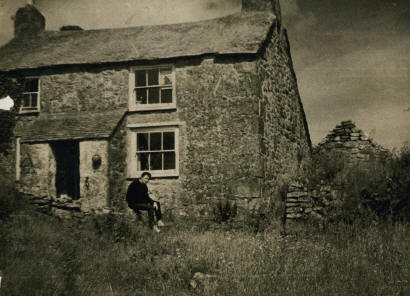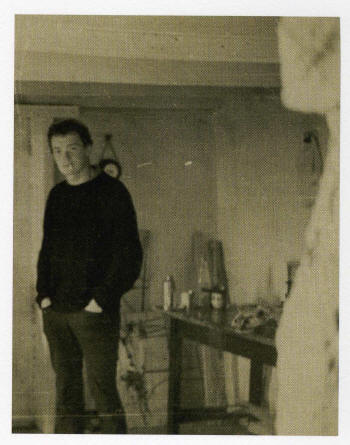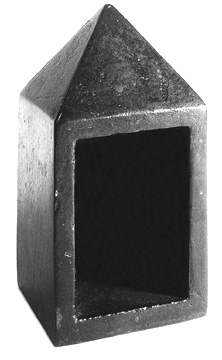|
|
| home | features | exhibitions | interviews | profiles | webprojects | gazetteer | links | archive | forum |
|
Bob Law on the radio
Interview by Roger Taylor
Bob Law was Britain's leading minimalist artist. In 1989, he showed at Clinton Tweedie's 312 Lenox Street Gallery in Melbourne. There he was interviewed by Roger Taylor of Radio 3RRR. The following are verbatim quotations taken from his replies.
'I rented the cottage from an artist called Trevor Bell. Roger Hilton bought it for £400 when I left Cornwall. No water, no electric, no gas, nothing, just a stand pipe outside'. 'The Black Paintings started in 1960 in the cottage in Cornwall. Then they were thick impasto paint put on with a blade, made from powder pigment and linseed oil and lots of other ingredients because I just couldn't afford tube paint. They have all gone, disappeared, gone, destroyed, got lost. There's none left'.
'I gave up the series of Black Paintings and there was also a series of White paintings on raw canvas with just a line round the edge. I did about a hundred Black Paintings through the years and I just couldn't do them any more. I got to the end of the line'. 'I took up sculpture. Then in a few years...a few bits of sculpture - its exciting at first and then it gets harder and harder. Something with sort of A B C - minimal shapes in sculpture, simple pyramids and obelisks and balls, then along came the chairs. A lot of people wanted Black Paintings and there weren't any left so I did this series of black watercolours - which include all the colours - red, yellow, blue, green and purple - layers and layers and layers of thin watercolour built up until you get this blackness with all the depth of colour in it. I did a series of about sixty over a period of eighteen months. More or less the same technique only watercolour instead of acrylic'.
On the Lisson Gallery and Karsten Schubert
On the Last Supper (above) 'I'd made a few chairs and I was looking through some books one day and I saw Leonardo Da Vinci's Last Supper. I thought, that's a good subject - everyone tries it so l think I'll have a go at it. I made it without the figures so that the broken chair is Judas' chair and the centre chair with the cross in is Christ's chair - and then the other common disciples' chairs - and I made it in a most simple way, worked out all the proportions of the spaces between the legs and the backs, in wood and then I had it cast in bronze'.
'I used to sit and look at my Black Paintings for hour after hour and meditate on them and one day I got in such a state - and I thought the painting is here and I'm sitting in this chair and I'd like to make this whole thing - I'd like to make the thing I'm sitting in - a chair- as a contemplative object'. 'It's also structurally... you have a foundation which gives you a discipline to work to and it has logic - it's just not abstract but it is built in a most simple three-dimensional way. I made them from scrap wood and split, chopped with the grain, and just slot them together, glue them up, clamp them...and later on, last year, I started collecting driftwood on the pebble beaches of Kent, and trying to use the wood as I found it and fitting it together and the beautiful silvery salt bleached timber - just leave it natural - just glue it up'.
'I lived on Richmond Hill from 1964 to 1969. I was doing Black Paintings and writing poetry in lead, which I've always been interested in. They were to do with my experience of the countryside, which I'd just left'. 'The letters are stamped on with letter stamps - that's all really. It was mostly old lead from old roofs, scrap yards. The Dog Poems - they are to do with... they go back to some of the old original field drawings and relate to one particular poem about a dog on the far side of his field. When he looks out across the field, and you've got to think how a dog thinks - that dog marks his own territory by urinating around that field and it becomes his field - and if any other dogs come in there it gets angry, so l divided up these lead pieces in fields and just worked with three dogs, to see how many I could get in each different field and I got six different poems from it'.
'It's a shape that's been with me from the very beginnings of my drawings - over a long period of time, it became an obelisk'.
'I used to go out in the fields and lay down and watch - it's very windy down there (Cornwall) - and watch the clouds race across and feel the earth spinning, feel the wind, watch the trees - just looking up in the sky and this is a sort of plan of those experiences I had laying in those remote places. The smoke coming out is a formulation of what I described as energy. I would have loved to have made sculptures from them but it's an impossible configuration. There's no way you could make sculpture of it so l just left them as drawings. You think twenty-four hours a day and you work four hours. It's just got to be good, truthful, strong - I don't like fussy paintings and people that work laboriously. I like strong simple statements. This is a poem I wrote in Twickenham, when I'd just built my new studio: Is a mind a prison of cells
Thanks to Vanessa Law. The estate of Bob law is represented by Richard Saltoun. Please contact info@richardsaltoun.com. See 'profiles' for more info and 'exhibitions' for pictures of recent London retrospective. |
|
|

 On his move to St Ives in 1957
On his move to St Ives in 1957
 'Nicholas Logsdail was very important. I
was with him when he first began. He was an antique dealer and then an artist himself...
He started collecting interesting artists
around him and started a gallery - just an old butchers shop in
those days. He's done very well. Karsten Schubert was Nicholas
Logsdail's assistant and he split off after learning the trade and
asked me whether I'd go with him because I hadn't been doing too well
at that time so I went with him. That's it. That's the way the cookie
crumbles'.
'Nicholas Logsdail was very important. I
was with him when he first began. He was an antique dealer and then an artist himself...
He started collecting interesting artists
around him and started a gallery - just an old butchers shop in
those days. He's done very well. Karsten Schubert was Nicholas
Logsdail's assistant and he split off after learning the trade and
asked me whether I'd go with him because I hadn't been doing too well
at that time so I went with him. That's it. That's the way the cookie
crumbles'. 
